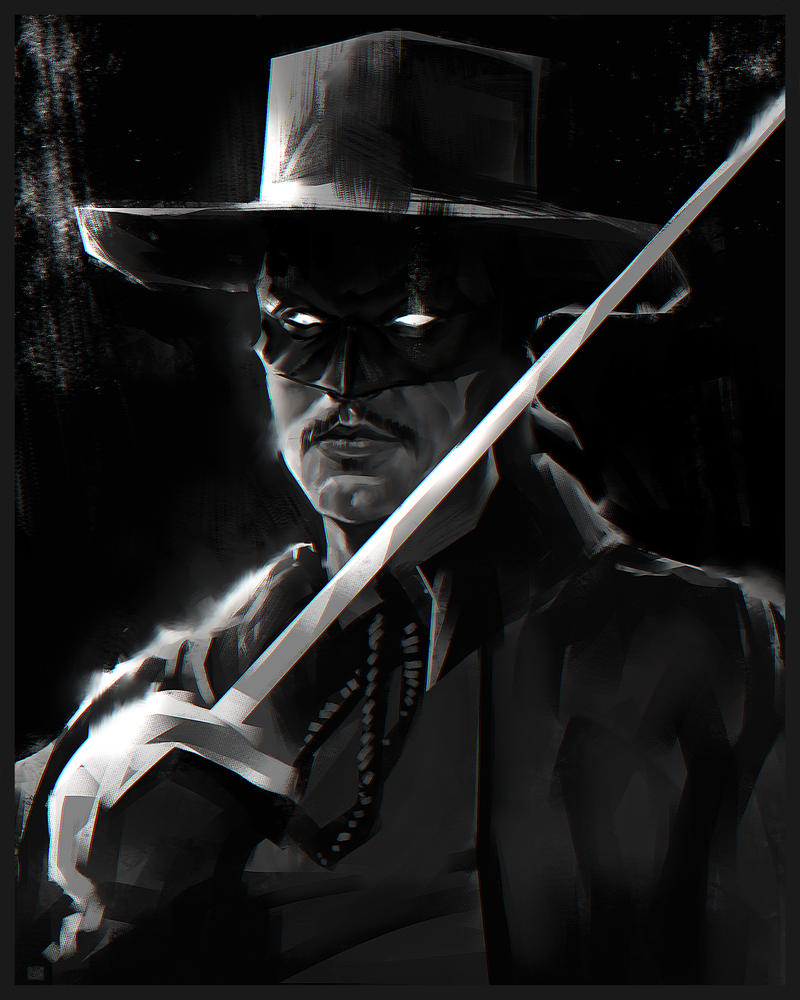Z
is the memory of scratching
a letter into a car's fresh hot
red paint job, hot red the shade
of my face thinking about it,
hot red, the anger of my parents
at finding it, a deep crimson
realizing I am not Zorro,
probably never will be.

Zorro -- Danar Worya
Zorro (Spanish for "fox") was created in 1919 by pulp writer Johnston McCulley and debuted in "The Curse of Capistrano," a five-part serial in "All-Story Weekly." He was a Californio in Los Angeles when it was part of Mexico (between 1821 and 1846) who, in order to defend the people against bumbling, tyrannical officials, disguised himself in a black costume with a flowing Spanish cape, a flat-brimmed black sombrero cordobés, and a black cowl sackcloth domino mask that covers the top of the head from eye level upwards. (In his first appearance, he wore a cloak instead of a cape, and a black cloth veil mask with slits for eyes covered his whole face.) His favored weapon was a rapier, with which carved his distinctive mark, a Z cut with three quick strokes, but also used a bullwhip upon occasion. When "Everybody's Hero" Douglas Fairbanks and "America's Sweetheart" Mary Pickford were on their honeymoon, they chose that story as the inaugural movie for their new studio, United Artists (founded with Charlie Chaplin and D. W. Griffith to protect their interests from the studios by giving them complete artistic control over their films and profits). Until then Fairbanks had made 28 feature films and a two-reel short which showcased his ebullient screen persona and athletic ability, but he had been a comic; however, he wanted to move into adventure-costume pictures, a genre that was out of favor with the public. "The Mark of Zorro" appeared in 1920 and starred Fairbanks, to tremendous success; the original story, renamed with the movie's title, was republished in book form by Grosset & Dunlap. McCulley's second Zorro serial, "The Further Adventures of Zorro," appeared in 1922 in "Argosy Magazine," which had absorbed "All-Story," but he wrote no more of them until "Zorro Rides Again" in 1931, followed by another gap in which McCulley pursued other writing projects. Republic optioned the character for a movie serial, "Zorro's Fighting Legion" starring Reed Hadley, which was released in 1939, and over the coming decade the studio released three other serials connected with the Zorro character. However, the box office success of the 1940 remake of "The Mark of Zorro" with Tyrone Power and Linda Darnell led to McCulley's own return to the character in "The Sign of Zorro" in "Argosy" in 1941. Then he agreed to provide a new Zorro story for every issue of "West Magazine" from July 1944 to July 1951, the final issue of the publication. One more (possibly written for "West" but unpublished) appeared in the May 1954 issue of "Max Brand's Western Magazine." His final Zorro story, "The Mask of Zorro" appeared in "Short Story Magazine" in April 1959, after his death in 1958, spurred by Walt Disney's Zorro television series (1957-1959 and 1960–1961) starring Guy Williams. Altogether, between 1919 and 1959 McCulley wrote more than 60 more Zorro stories. McCulley did not worry much about consistency; "Señor Zorro's" alter ego was Don Diego Vega at first but in later stories his surname became de la Vega; the first serial ended with Capt. Ramon the villain dead and Diego publicly exposed as Zorro, but in the 1922 sequel Ramon was still alive and the double identity still secret; most commonly he rode a black horse named Tornado or Toronado or Tempest, but sometimes it was a white horse named Phantom.
ReplyDeleteThe character has been featured in numerous books (notably Isabel Allende's 2005 "Zorro," a prequel to the original story), radio, comic books (often featuring artwork by Alex Toth),and other media, including over 40 films such as the Fairbanks 1925 sequel "Don Q, Son of Zorro." "The Bold Caballero" with Robert Livingston (1936), "Ghost of Zorro," a 1949 movie serial starring Clayton Moore shortly before he starred in the somewhat-similar "Lone Ranger" TV series, "La montaña sin ley" (1953) with José Suárez, the first Spanish actor to play the role, "La Gran Aventura Del Zorro" (1976) with Rodolfo de Anda, the first Mexican actor to do so, "Zorro, The Gay Blade," a parody with George Hamilton (1981), and two Antonio Banderas movies, "The Mask of Zorro" (1998) and "The Legend of Zorro" (2005). Michael Smuin's modern ballet version premiered in the Yerba Buena Center for the Arts in San Francisco in 2003, with music by Charles Fox and Matthew Robbins. A musical directed by Christopher Renshaw, choreographed by Rafael Amargo, and scored by the Gipsy Kings debuted in London in 2008 and was nominated for 5 Oliviers, including Best Musical.
ReplyDelete